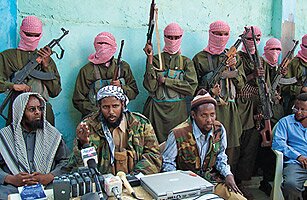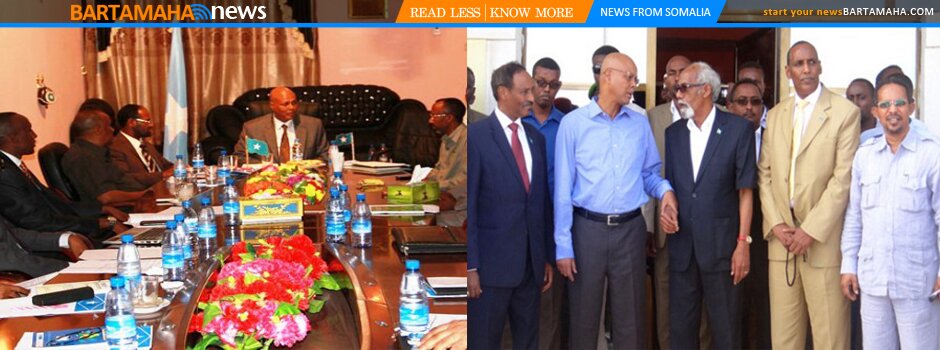The Rise of Extremism in Somalia
 On the night of Sept. 21 last year, U.S. diplomatic staff in South Africa were telephoned at home and told not to go to work the next day. A State Department official refused to explain the warning, but a Western intelligence officer in Africa told TIME the alarm was raised after a phone call from an al-Qaeda operative to a number in Cape Town was intercepted — a call in which an attack on U.S. government buildings in South Africa was discussed. No attack took place, and after three days, the embassy in Pretoria and three consulates reopened. But with South Africa expecting half a million fans for the soccer World Cup this June and July, security officials are understandably jittery. Especially because of the origin of the phone call. It came, TIME was told, from Somalia.
On the night of Sept. 21 last year, U.S. diplomatic staff in South Africa were telephoned at home and told not to go to work the next day. A State Department official refused to explain the warning, but a Western intelligence officer in Africa told TIME the alarm was raised after a phone call from an al-Qaeda operative to a number in Cape Town was intercepted — a call in which an attack on U.S. government buildings in South Africa was discussed. No attack took place, and after three days, the embassy in Pretoria and three consulates reopened. But with South Africa expecting half a million fans for the soccer World Cup this June and July, security officials are understandably jittery. Especially because of the origin of the phone call. It came, TIME was told, from Somalia.
Somalia is much on the minds of those fighting terrorism these days. On Feb. 1, Sheik Fuad Mohamed Shangole, a leader of an Islamist group known as al-Shabab (the Youth), which is fighting for control of the nation on the Horn of Africa, made a public declaration of allegiance to Osama bin Laden. If that summons memories of the old relationship between the Afghan Taliban and bin Laden, it should. Both Somalia and Afghanistan have been at war for more than a generation. Both wars have followed a similar progression: a toppling of the central government that was followed by years of warlord feuding (18 U.S. soldiers died protecting a U.N. mission in Mogadishu in 1993, an episode that later became the subject of the book and film Black Hawk Down) and then the rise of a movement — the Taliban in Afghanistan, al-Shabab in Somalia — that proposed an extremist vision of Islam as a solution to the lawlessness. The two countries are both poor and populated mostly, it can often seem, by men with a uniform taste for beards, AK-47s and pickup trucks.
For years, when it came to host countries, al-Qaeda seemed to prefer the inaccessible mountains of the Afghanistan-Pakistan border to Somalia’s flat, open scrub. The handful of jihadis based in Somalia staged international attacks: in August 1998, they killed 224 people in twin bombings of the U.S. embassies in Nairobi and Dar es Salaam, Tanzania, and in November 2002, 13 people died after a car-bomb attack on an Israeli-owned hotel on Kenya’s coast. But they attempted nothing on the scale of Sept. 11. Now there is a fear that their ambitions may be rising. The worry over Somalia also has a regional dimension: just across the Gulf of Aden is Yemen, long a staging ground for al-Qaeda attacks and the place where Umar Farouk Abdulmutallab, the Nigerian who tried to blow up a flight to Detroit on Christmas Day, is thought to have been trained.
Al-Shabab’s Long Reach
If Somalia’s extremists are becoming an international threat, that’s partly because of their cosmopolitan leadership. One sure result of war is refugees, and decades of fighting in Somalia have seen the rapid growth of a large Somali diaspora in places from Cape Town to Minneapolis. But not all who have been forced to make new lives far away from Africa have done so easily. The past few years have seen the arrival in Somalia of 200 to 300 young ethnic Somali men from the U.S., Britain, Canada, Australia, Norway and Sweden, migrants’ children returning to their ancestral homeland, according to diplomatic and intelligence sources in East Africa. A Western soldier working in Somalia says these foreign-born Somalis now dominate al-Shabab. “All their cells are commanded by a foreigner,” he says. “All tactical and strategic decisions are taken by foreigners.”
To extend their reach overseas, al-Shabab’s leaders in Somalia are thought to circle back to the diaspora, looking for those who can be recruited to extremism. The FBI is tracking more than a dozen Somali Americans who disappeared from their homes and are suspected of joining al-Shabab, and in November, 14 Minnesota men with connections to Somalia were charged with offenses like aiding a terrorist organization; four have pleaded guilty. In August, Australian police arrested five men from the Somali community in Melbourne on suspicion of plotting to attack an army barracks outside Sydney. The September call to Cape Town was picked up because a group of ethnic Somalis in the city were already under surveillance on suspicion of raising funds for al-Shabab, according to the intelligence officer. “If you’ve been waiting for a moment to declare Somalia a priority threat, what else do you need?” asks the Western soldier in Somalia. “There’s no longer a serious risk that southern Somalia could become a jihadi operational deployment facility. It already is.”
So how to respond? In Somalia, authority is notionally held by the Transitional Federal Government (TFG), led by an Islamist who preaches pragmatic engagement with the West. The TFG was installed by Ethiopia, a principal U.S. ally in Africa, after its forces invaded Somalia in 2006 and toppled an earlier Islamist government whose more extreme members had unwisely declared jihad on Somalia’s bigger and more Christian neighbor to the west. But many members of the TFG seem to effectively live in Nairobi. (Exceptions include President Sheik Sharif Ahmed and his Defense Minister, Yusuf Mohamed Siad, a veteran warlord who survived an assassination attempt by suicide bomb in Mogadishu on Feb. 15.) Despite the protection of 5,300 African Union (A.U.) troops — mainly Ugandans and Burundians — the TFG in reality controls little more than a few blocks of Mogadishu. “To defeat the Shabab,” says the intelligence officer, “you need a functioning government. That’s exactly what they lack.”
From outside Africa, the response has been patchy. There is some financial assistance, much of it from the U.S. (The A.U. peacekeepers have cost $160 million so far.) In 2007, the U.S. sent special-operations teams in with the Ethiopians and — says Abdirashid Mohamed Hiddig, a Somali Member of Parliament who assisted the Americans — captured 10 to 20 foreign fighters. Since then, according to Pentagon spokesmen, the U.S. has carried out at least six aerial attacks inside Somalia, killing al-Shabab leader Aden Hashi Farah Ayro, who was hit by a missile in May 2008, and Saleh Ali Saleh Nabhan, the mastermind of the 2002 attack in Kenya, who was killed by U.S. helicopter gunships last September. The U.S. has had no military support from other nations, although some have made contributions to help deal with Somalia’s long humanitarian crisis. Only piracy and the threat it poses to world trade have resulted in concerted international muscle. An armada of warships from more than 20 countries now hunts pirates and escorts convoys of merchant vessels in the Gulf of Aden and the Indian Ocean.
All that said, the threat from Somalia needs to be kept in perspective. Al-Shabab is far smaller than the Taliban. “There are bigger gangs in L.A.,” says the intelligence officer. It is prone to factionalism and has found it hard to garner support among ordinary Somalis. The U.N. has reported that al-Shabab receives funds and weapons from the Middle East and the Eritrean government. (Al-Shabab fights Ethiopia, and Ethiopia is Eritrea’s archenemy.) But that support is small compared with the assistance that extremist groups in Pakistan and Afghanistan have received from radical Islamists around the world. Finally, the risk that Somalia could ignite a wider conflagration across the Horn of Africa — sucking in Ethiopia, Eritrea and even Kenya — is real but, again, nothing like the one in Afghanistan’s neighborhood. As U.S. ambassador to Kenya Michael Ranneberger never tires of pointing out, none of Somalia’s neighbors are nuclear powers. “We are a little wary of the comparisons,” he says.
But in the asymmetrical calculations of terrorism, small numbers aren’t the key; determination to do damage is. As Ranneberger concedes, no change in Somalia means “further deterioration.” Increasingly bold ways of dealing with al-Shabab are being considered. The A.U. peacekeeping force is being expanded, with the hope of creating a “green zone” in Mogadishu. Hundreds of al-Shabab fighters have been pouring into Mogadishu recently in anticipation of a rumored TFG offensive. Ugandan President Yoweri Museveni has gone further, proposing invading Somalia, occupying the southern port of Kismayu and using it to take the fight to al-Shabab. Memories of the disastrous intervention in 1993 remain sharp, so that is not a proposal that seems likely ever to gain much U.S. support. But it is a measure of the increasing anxiety that Somalia inspires that it is still on the table.
_____
Time
Comments
comments
 Calendar
Calendar






































